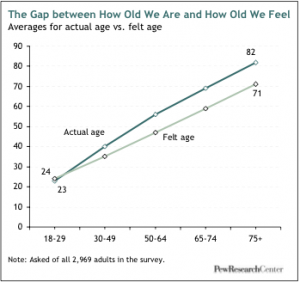You’ve heard the phrase, “You’re only as old as you feel.” There is mounting evidence that, to a large extent, this cliché isn’t too far off. In several different studies, researchers have explored the difference between people’s chronological age (their age based on the number of trips they’ve made around the sun) and their subjective age, which is how old they feel on the inside. The results may surprise you!
The gap between chronological and subjective age
The 2009 Pew Research Center Social and Demographic Trends survey on aging examined a sample of 2,969 Americans, age 18 and up. The researchers discovered a notable difference between what the young and middle-aged adults expected old age to be like and the actual lived experiences reported by the older study participants.
Among the questions in the survey, participants were asked how old they feel, in years. Interestingly, the Pew research team found that the older people get, the younger they feel. For example, among the 18- to 29-year-olds in the study, about half reported feeling their age, while about a quarter said they felt older than their age. Among the adults 65 and older, on the other hand, 60 percent reported that they feel younger than their age and 32 percent said they felt exactly their age. A mere 3 percent of the age 65+ respondents said they felt older than their chronological age.

Image credit: Pew Research Center
Based on this study’s findings, the gap in years between chronological (actual) age and subjective (felt) age appears to grow wider as people get older. The Pew researchers discovered that almost half of survey respondents who were age 50 and older said they felt at least 10 years younger than their chronological age. Even more striking, though, among those 65 to 74 years old, a third responded that they felt between 10 and 19 years younger than their chronological age. One out of six study participants in this age group said they felt at least 20 years younger than their actual age!
>> Related: Marketing CCRCs to the Next Generation of Retirees
Is age just a number?
A 2008 study conducted in Norway had a similar outcome as the Pew study. Norwegian researchers surveyed 2,471 people who were between 40 and 79 years old at the start of the study to determine their subjective age perception (SAP, or how old they feel on the inside) and then surveyed them again five years later.
The researchers found that most survey respondents felt younger than their chronological age, and this was especially true the older the participant. For the oldest study participants, age 70 to 79, good mental and physical health were the primary predictors of a younger SAP.
Perhaps more interesting, however, a 2019 study published in the International Journal of Aging Research found that even seniors with multiple illnesses or health conditions reported feeling subjectively younger than their chronological age.
The study surveyed Canadians and Americans between 65 and 90 years old — with an average age of 73 — and asked them about how old they felt on the inside (again, their self-reported subjective age). Their responses revealed that, despite their multiple health issues, the participants reported an average subjective age of just 51 years old. That’s an average difference of more than 20 years between subjective age and chronological age. Some respondents even said they felt as young as 17. Additionally, only 8 percent of the study’s participants reported that they felt the same age inside as their chronological age.
>> Related: CCRCs Need to Solve the “Not Ready Yet” Demographic Issue
Today’s older people are “younger”
It’s not your imagination: Many of today’s seniors actually are more youthful (both physically and mentally) than their peers in previous generations, and a 30-year study out of Finland confirms it.
In the study, the first cohort of 500 Finns were born in 1910 and 1914 and were assessed in the mid-1980s when they were age 75 and 80 years, respectively. The second cohort of 726 people were born in 1938 or 1939 and 1942 or 1943 and were assessed 30 years after the first cohort, but also at age 75 and 80 years, respectively. The modern group (those born in the 1930s and ‘40s) showed substantial differences:
- Their walking speeds were .2 to .4 meters per second faster than the earlier cohort’s.
- Grip strength was 5 to 25 percent stronger than the earlier group’s.
- Their knee extension strength was 20 to 47 percent higher.
- They had better verbal fluency, reasoning, and working memory than the earlier cohort.
Overall, the later cohort showed “markedly and meaningfully higher results in the maximal functional capacity tests,” which suggests that Finns who are currently 75 and 80 years old are living longer and have better physical functioning.
>> Related: Another Study Finds Potential Health Benefits to Living in a CCRC
Creating more tailored messaging
Understanding that today’s seniors feel younger than their actual age is important on a number of fronts.
For example, this discrepancy between subjective age and chronological age may help explain why some seniors fail to comply with age-based medical recommendations such as preventive screenings. The “young at heart” senior may feel that such guidance is for “old people…and I’m not old.” This can lead to the onset of preventable health conditions among this demographic.
Similarly, policymakers and administrators within the senior living industry must also heed these insights about seniors’ perceptions of their age. Indeed, using language or branding that includes the word “senior” may miss the mark with this audience, since they may perceive that word to be about people older than themselves. Instead, language like “active” or “young inside” might offer more appeal to today’s older people.

FREE Detailed Profile Reports on CCRCs/Life Plan Communities
Search Communities






